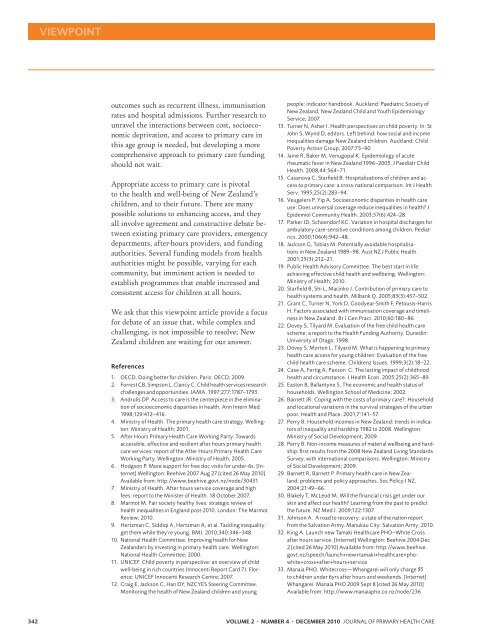The requirement to respect autonomy - The Royal New Zealand ...
The requirement to respect autonomy - The Royal New Zealand ...
The requirement to respect autonomy - The Royal New Zealand ...
- No tags were found...
You also want an ePaper? Increase the reach of your titles
YUMPU automatically turns print PDFs into web optimized ePapers that Google loves.
viewpoin<strong>to</strong>utcomes such as recurrent illness, immunisationrates and hospital admissions. Further research <strong>to</strong>unravel the interactions between cost, socioeconomicdeprivation, and access <strong>to</strong> primary care inthis age group is needed, but developing a morecomprehensive approach <strong>to</strong> primary care fundingshould not wait.Appropriate access <strong>to</strong> primary care is pivotal<strong>to</strong> the health and well-being of <strong>New</strong> <strong>Zealand</strong>’schildren, and <strong>to</strong> their future. <strong>The</strong>re are manypossible solutions <strong>to</strong> enhancing access, and theyall involve agreement and constructive debate betweenexisting primary care providers, emergencydepartments, after-hours providers, and fundingauthorities. Several funding models from healthauthorities might be possible, varying for eachcommunity, but imminent action is needed <strong>to</strong>establish programmes that enable increased andconsistent access for children at all hours.We ask that this viewpoint article provide a focusfor debate of an issue that, while complex andchallenging, is not impossible <strong>to</strong> resolve; <strong>New</strong><strong>Zealand</strong> children are waiting for our answer.References1. OECD. Doing better for children. Paris: OECD; 2009.2. Forrest CB, Simpson L, Clancy C. Child health services research:challenges and opportunities. JAMA. 1997;277:1787–1793.3. Andrulis DP. Access <strong>to</strong> care is the centerpiece in the eliminationof socioeconomic disparities in health. Ann Intern Med.1998;129:412–416.4. Ministry of Health. <strong>The</strong> primary health care strategy. Welling<strong>to</strong>n:Ministry of Health; 2001.5. After Hours Primary Health Care Working Party. Towardsaccessible, effective and resilient after hours primary healthcare services: report of the After Hours Primary Health CareWorking Party. Welling<strong>to</strong>n: Ministry of Health; 2005.6. Hodgson P. More support for free doc visits for under-6s. [Internet]Welling<strong>to</strong>n: Beehive 2007 Aug 27 [cited 26 May 2010]Available from: http://www.beehive.govt.nz/node/304317. Ministry of Health. After hours service coverage and highfees: report <strong>to</strong> the Minister of Health. 18 Oc<strong>to</strong>ber 2007.8. Marmot M. Fair society healthy lives: strategic review ofhealth inequalities in England post-2010. London: <strong>The</strong> MarmotReview; 2010.9. Hertzman C, Siddiqi A, Hertzman A, et al. Tackling inequality:get them while they’re young. BMJ. 2010;340:346–348.10. National Health Committee. Improving health for <strong>New</strong><strong>Zealand</strong>ers by investing in primary health care. Welling<strong>to</strong>n:National Health Committee; 2000.11. UNICEF. Child poverty in perspective: an overview of childwell-being in rich countries (Innocenti Report Card 7). Florence:UNICEF Innocenti Research Centre; 2007.12. Craig E, Jackson C, Han DY, NZCYES Steering Committee.Moni<strong>to</strong>ring the health of <strong>New</strong> <strong>Zealand</strong> children and youngpeople: indica<strong>to</strong>r handbook. Auckland: Paediatric Society of<strong>New</strong> <strong>Zealand</strong>, <strong>New</strong> <strong>Zealand</strong> Child and Youth EpidemiologyService; 2007.13. Turner N, Asher I. Health perspectives on child poverty. In: StJohn S, Wynd D, edi<strong>to</strong>rs. Left behind: how social and incomeinequalities damage <strong>New</strong> <strong>Zealand</strong> children. Auckland: ChildPoverty Action Group; 2007:73–90.14. Jaine R, Baker M, Venugopal K. Epidemiology of acuterheumatic fever in <strong>New</strong> <strong>Zealand</strong> 1996–2005. J Paediatr ChildHealth. 2008;44:564–71.15. Casanova C, Starfield B. Hospitalizations of children and access<strong>to</strong> primary care: a cross-national comparison. Int J HealthServ. 1995;25(2):283–94.16. Veugelers P, Yip A. Socioeconomic disparities in health careuse: Does universal coverage reduce inequalities in health? JEpidemiol Community Health. 2003;57(6):424–28.17. Parker JD, Schoendorf KC. Variation in hospital discharges forambula<strong>to</strong>ry care-sensitive conditions among children. Pediatrics.2000;106(4):942–48.18. Jackson G, Tobias M. Potentially avoidable hospitalisationsin <strong>New</strong> <strong>Zealand</strong> 1989–98. Aust NZ J Public Health.2001;25(3):212–21.19. Public Health Advisory Committee. <strong>The</strong> best start in life:achieving effective child health and wellbeing. Welling<strong>to</strong>n:Ministry of Health; 2010.20. Starfield B, Shi L, Macinko J. Contribution of primary care <strong>to</strong>health systems and health. Milbank Q. 2005;83(3):457–502.21. Grant C, Turner N, York D, Goodyear-Smith F, Pe<strong>to</strong>usis-HarrisH. Fac<strong>to</strong>rs associated with immunisation coverage and timelinessin <strong>New</strong> <strong>Zealand</strong>. Br J Gen Pract. 2010;60:180–86.22. Dovey S, Tilyard M. Evaluation of the free child health carescheme: a report <strong>to</strong> the Health Funding Authority. Dunedin:University of Otago; 1998.23. Dovey S, Mor<strong>to</strong>n L, Tilyard M. What is happening <strong>to</strong> primaryhealth care access for young children: Evaluation of the freechild health care scheme. Childrenz Issues. 1999;3(2):18–22.24. Case A, Fertig A, Paxson C. <strong>The</strong> lasting impact of childhoodhealth and circumstance. J Health Econ. 2005;25(2):365–89.25. Eas<strong>to</strong>n B, Ballantyne S. <strong>The</strong> economic and health status ofhouseholds. Welling<strong>to</strong>n School of Medicine; 2002.26. Barnett JR. Coping with the costs of primary care?: Householdand locational variations in the survival strategies of the urbanpoor. Health and Place. 2001;7:141–57.27. Perry B. Household incomes in <strong>New</strong> <strong>Zealand</strong>: trends in indica<strong>to</strong>rsof inequality and hardship 1982 <strong>to</strong> 2008. Welling<strong>to</strong>n:Ministry of Social Development; 2009.28. Perry B. Non-income measures of material wellbeing and hardship:first results from the 2008 <strong>New</strong> <strong>Zealand</strong> Living StandardsSurvey, with international comparisons. Welling<strong>to</strong>n: Ministryof Social Development; 2009.29. Barnett R, Barnett P. Primary health care in <strong>New</strong> <strong>Zealand</strong>:problems and policy approaches. Soc Policy J NZ.2004;21:49–66.30. Blakely T, McLeod M. Will the financial crisis get under ourskin and affect our health? Learning from the past <strong>to</strong> predictthe future. NZ Med J. 2009;122:1307.31. Johnson A. A road <strong>to</strong> recovery: a state of the nation reportfrom the Salvation Army. Manukau City: Salvation Army; 2010.32. King A. Launch new Tamaki Healthcare PHO–White Crossafter hours service. [Internet] Welling<strong>to</strong>n: Beehive 2004 Dec2 [cited 26 May 2010] Available from: http://www.beehive.govt.nz/speech/launch+new+tamaki+healthcare+phowhite+cross+after+hours+service33. Manaia PHO. Whitecross—Whangarei will only charge $5<strong>to</strong> children under 6yrs after hours and weekends. [Internet]Whangarei: Manaia PHO 2009 Sept 8 [cited 26 May 2010]Available from: http://www.manaiapho.co.nz/node/236342 VOLUME 2 • NUMBER 4 • DECEMBER 2010 J OURNAL OF PRIMARY HEALTH CARE
















